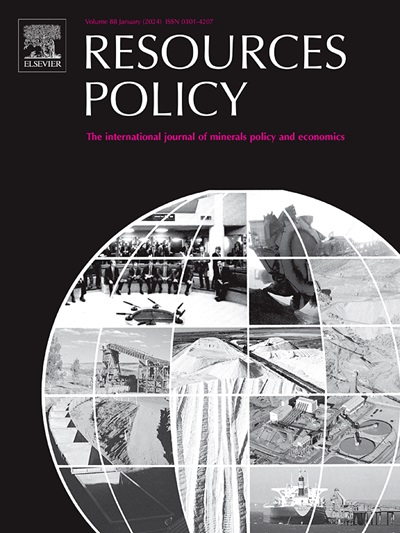金属和矿物生产的累积能源需求和全球变暖潜势:评估、预测和缓解备选办法
IF 10.2
2区 经济学
0 ENVIRONMENTAL STUDIES
引用次数: 0
摘要
本研究估算了50种金属和22种非金属商品的累计能源需求和全球变暖潜势,并基于Ecoinvent 3.8数据库,通过低、高和中位数三种不同的评估纳入了不确定性。结果显示,2019年,这些大宗商品的累计能源需求占全球一次能源消费的11.3%至18.2%,中位数估计为13.8%。同样,全球变暖潜势占同年全球温室气体(GHG)排放量的13.4%-19.1%,估计中值为17.7%。钢铁、铝和水泥生产成为主要贡献者,在所有情景下,它们约占累计能源需求的80%,占温室气体排放量的90%。该研究还量化了中国钢铁生产中加强回收和加速采用电弧炉技术的潜在环境效益。这些措施有可能使全球累计能源需求分别减少2.1%和1.6%,温室气体排放量分别减少1.8%和0.9%。该分析利用国际能源署的可持续发展情景进一步研究了清洁能源转型所需的采矿对能源和气候的影响。考虑到目前的开采技术,与此情景相关的生产盈余将使全球累计能源需求增加1.1%,全球变暖潜力增加0.6%。然而,这些增长将被化石燃料消耗的相应减少所抵消。本文最后讨论了与金属和矿物生产的环境负担最相关的部门和区域,并强调了减轻这些影响的关键战略。本文章由计算机程序翻译,如有差异,请以英文原文为准。
Cumulative Energy Demand and Global Warming Potential of metals and minerals production: Assessment, projections and mitigation options
This study estimates the cumulative energy demand and global warming potential for 50 metals and 22 non-metallic commodities, incorporating uncertainties through three distinct assessments: low, high, and median, based on the Ecoinvent 3.8 database. The results show that the cumulative energy demand of these commodities represents between 11.3% and 18.2% of global primary energy consumption in 2019, with a median estimate of 13.8%. Similarly, the global warming potential accounts for 13.4%–19.1% of global greenhouse gas (GHG) emissions in the same year, with a median estimate of 17.7%. Iron and steel, aluminum, and cement production emerge as the dominant contributors, responsible for approximately 80% of cumulative energy demand and 90% of GHG emissions across all scenarios. The study also quantifies the potential environmental benefits of enhanced recycling and the accelerated adoption of electric arc furnace technology for steel production in China. These measures can potentially reduce global cumulative energy demand by up to 2.1% and 1.6% respectively and GHG emissions by up to 1.8% and 0.9%. The analysis further examines the energy and climate impacts of mining requirements for a clean energy transition, using IEA's Sustainable Development Scenario. Considering current extraction technologies, the production surplus associated with this scenario could increase global cumulative energy demand by 1.1% and global warming potential by 0.6%. However, these increases would be outweighed by the corresponding reductions in fossil fuel consumption. The paper concludes by discussing the sectors and regions most associated with the environmental burdens of metal and mineral production and highlight key strategies for mitigating these impacts.
求助全文
通过发布文献求助,成功后即可免费获取论文全文。
去求助
来源期刊

Resources Policy
ENVIRONMENTAL STUDIES-
CiteScore
13.40
自引率
23.50%
发文量
602
审稿时长
69 days
期刊介绍:
Resources Policy is an international journal focused on the economics and policy aspects of mineral and fossil fuel extraction, production, and utilization. It targets individuals in academia, government, and industry. The journal seeks original research submissions analyzing public policy, economics, social science, geography, and finance in the fields of mining, non-fuel minerals, energy minerals, fossil fuels, and metals. Mineral economics topics covered include mineral market analysis, price analysis, project evaluation, mining and sustainable development, mineral resource rents, resource curse, mineral wealth and corruption, mineral taxation and regulation, strategic minerals and their supply, and the impact of mineral development on local communities and indigenous populations. The journal specifically excludes papers with agriculture, forestry, or fisheries as their primary focus.
 求助内容:
求助内容: 应助结果提醒方式:
应助结果提醒方式:


